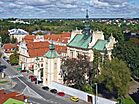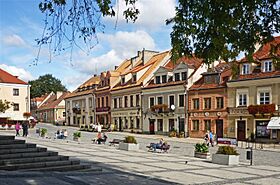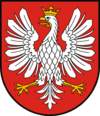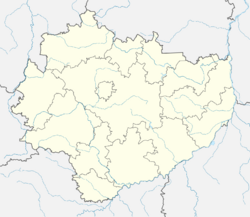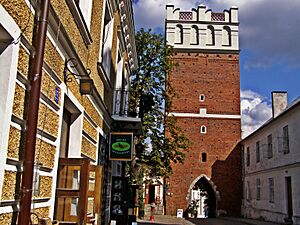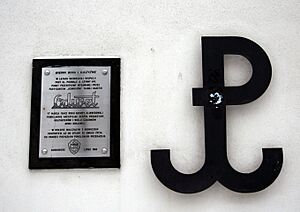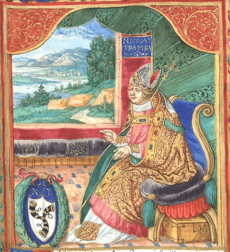Sandomierz facts for kids
Quick facts for kids
Sandomierz
|
|||
|---|---|---|---|
|
Left to right: Town Hall, St. Michael's Church, Sandomierz Castle, Bishops' Palace, Old townhouses at the Market Square
|
|||
|
|||
| Country | |||
| Voivodeship | |||
| County | Sandomierz County | ||
| Gmina | Sandomierz (urban gmina) | ||
| Town rights | before 1227 | ||
| Area | |||
| • Total | 28.8 km2 (11.1 sq mi) | ||
| Elevation | 200 m (700 ft) | ||
| Population
(2017)
|
|||
| • Total | 23,863 | ||
| • Density | 828.6/km2 (2,146/sq mi) | ||
| Time zone | UTC+1 (CET) | ||
| • Summer (DST) | UTC+2 (CEST) | ||
| Postal code |
27-600
|
||
| Area code(s) | +48 15 | ||
| Car plates | TSA | ||
| National roads | |||
|
Invalid designation
|
|||
| Designated: | 2017-11-22 | ||
| Reference #: | Dz. U. z 2017 r. poz. 2273 | ||
Sandomierz is a historic town in south-eastern Poland. About 23,863 people lived there in 2017. It is located on the Vistula River, close to where the San joins it.
Sandomierz is part of the Świętokrzyskie Voivodeship (Holy Cross Province). It is also the main town of Sandomierz County. The town is famous for its well-preserved Old Town. This area is a big attraction for tourists and a very important cultural site. In 2017, the President of Poland even named it a National Monument of Poland.
In the past, Sandomierz was a very important city in Poland. It was a royal city for the Polish Crown. It also served as a main administrative center from the High Middle Ages until the 1800s.
Contents
What Does the Name Sandomierz Mean?
The name Sandomierz likely comes from an old Polish word, Sędomir. This word might combine Sędzi- (meaning "to judge") and mir (meaning "peace"). Another idea is that it comes from an old given name, Sędzimir, which was popular in Slavic languages.
In Latin, the town is called Sandomiria. In Yiddish, it is known as צויזמיר (Tzoyzmir).
Sandomierz Through Time
How Sandomierz Began
Sandomierz is one of Poland's oldest and most historically important cities. Scientists have found signs that people lived here since the neolithic period (the New Stone Age). The city started growing in the early Middle Ages. Its location was perfect, right where the Vistula and San rivers meet. It was also on important trade routes.
The first time Sandomierz was mentioned in history was in the early 1100s. A writer named Gallus Anonymus listed it as one of Poland's main cities, along with Kraków and Wrocław. Around 1115–1118, Bolesław III Wrymouth divided Poland among his sons. He made Sandomierz the capital of one of these new areas, called the Duchy of Sandomierz.
In the early 1200s, the second oldest Dominican monastery in Poland was built here. It was also one of the oldest in Europe. During the 1200s, the city was badly damaged by Mongol attacks in 1241, 1260, and 1287. The old wooden buildings were completely destroyed.
Because of this, in 1286, the Polish ruler Leszek II the Black rebuilt the city. He gave it new rights under Magdeburg Law, which helped it grow. The original document for this is still kept in the city's archives.
The Martyrs of Sandomierz
In 1260, during a Mongol attack, a group of Dominican friars in Sandomierz were praying. They heard a reading about "the 49 martyrs of Sandomir." They realized this was a warning of their own deaths. The friars spent the next day preparing. When the Mongols broke into their church, the friars were singing a special song to Mary, the Salve Regina. The Mongols killed them, and they became known as martyrs. Since then, Dominicans sing the Salve Regina when one of their members dies.
Sandomierz in the Middle Ages
After Poland was reunited in the 1300s, the area around Sandomierz became the Sandomierz Voivodeship. This was a large administrative region in southeastern Poland. Until 1474, it was one of two main regions in Lesser Poland, along with Kraków Voivodeship. Later, the Lublin Voivodeship was created from its eastern part.
At this time, Sandomierz had about 3,000 people and was one of Poland's biggest cities. In the mid-1300s, the city was burned again during an attack by the Lithuanians. King Casimir III of Poland rebuilt it and gave it more special rights. The way the city is laid out today is almost the same as it was back then. In 1389, a Lithuanian prince named Lengvenis paid respect to Polish King Władysław II Jagiełło in Sandomierz. This made Novgorod a part of the Kingdom of Poland.
Sandomierz in Recent Times
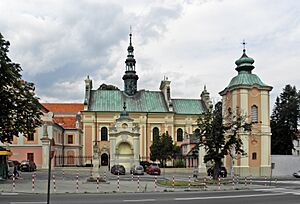
The time from the 1500s to the mid-1600s was very good for Sandomierz. Many important historical buildings were constructed then. This good time ended in 1655 when Swedish forces attacked the city during a period known as the Deluge. The Swedes blew up the castle and damaged other buildings before leaving.
For the next 100 years, Poland's economy declined, and Sandomierz suffered too. A big fire in 1757 and the Third Partition of Poland in 1795 further reduced its importance. Sandomierz lost its role as a main administrative center. In 1774, the oldest Polish piano still existing was made in Sandomierz.
Fighting during the Austro-Polish War in 1809 also damaged the city. After Poland won, Sandomierz became part of the Duchy of Warsaw for a short time. After 1815, it became part of the Russian Empire (called Congress Poland). At this point, only 2,640 people lived there.
The World Wars and Sandomierz
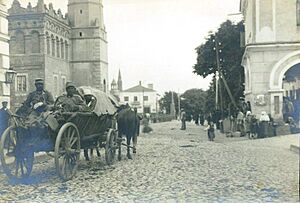
Sandomierz was damaged again during World War I. In 1918, Poland became independent again, and Sandomierz was part of it. In the 1930s, Sandomierz started to grow quickly because of a big public works project called the Central Industrial Area. There were plans for Sandomierz to become the capital of the Sandomierz Voivodeship, and local leaders hoped it would become a city of 120,000 people by the 1940s.
In September 1939, after Germany invaded Poland, the city was taken over by Germany. It became part of the General Government. Polish and Jewish people faced many terrible things. Poles who were forced out of their homes by Germans were sent to Sandomierz. Many people were forced to work and sent to labor camps. In March 1940, many Poles, including teachers and local leaders, were arrested. They were held in the local prison and sent to Nazi concentration camps.
In June 1940, in Brzask Forest, Germans killed 760 Poles. This was part of the German AB-Aktion in Poland, which aimed to eliminate Polish leaders and thinkers. Their bodies were buried in a mass grave. This was the largest massacre in the Kielce Region.
Despite this, the Polish underground resistance movement was active in Sandomierz. In late 1940, they even started a secret printing house and published an underground newspaper called Odwet. In March 1942, Germans arrested about 150 members of the Polish resistance. Among them was Polish writer Roman Koseła, who was later killed in the Auschwitz concentration camp.
In May 1942, Jewish and Polish people were forced into a ghetto area. Hundreds more Jews and Poles from nearby areas were brought there, making the population over 5,000. In October 1942, about 3,000 prisoners were sent to Bełżec, where they were immediately killed.
After this, hundreds of Jews who had been hiding came out. Others were sent to Sandomierz from different places. The population grew to over 6,000 people, all crowded into another ghetto. As many as twelve people shared each room, and some lived on the streets. Conditions were very bad, and many became sick. Those who went to the hospital were often shot after a few days.
Some prisoners were sent to labor camps. But in January 1943, the SS and German police surrounded the ghetto. They set some houses on fire and bombed others. They gathered 7,000 people, sent a few hundred to a labor camp, and marched the rest to the train station, killing hundreds along the way. The trains took the prisoners to Treblinka, where they were murdered the same day. Poles who helped Jews were also persecuted. Some were even imprisoned for simply "transporting Jews illegally." The city was taken by the Red Army in August 1944.
During the time of communist rule, Sandomierz did not have much industrial growth. This helped keep its charming, historic look among the beautiful landscape.
Weather in Sandomierz
Sandomierz has a humid continental climate. This means it has warm summers. Rain is more common in the summer months and decreases towards the end of winter. Sandomierz has four clear seasons: hot summers (sometimes), and usually cold but not extremely harsh winters.
| Climate data for Sandomierz (Chwałki), elevation: 217 m, 1991-2020 normals, extremes 1951–present | |||||||||||||
|---|---|---|---|---|---|---|---|---|---|---|---|---|---|
| Month | Jan | Feb | Mar | Apr | May | Jun | Jul | Aug | Sep | Oct | Nov | Dec | Year |
| Record high °C (°F) | 12.4 (54.3) |
18.7 (65.7) |
23.6 (74.5) |
29.7 (85.5) |
31.9 (89.4) |
34.2 (93.6) |
35.9 (96.6) |
37.1 (98.8) |
33.9 (93.0) |
25.4 (77.7) |
20.0 (68.0) |
16.0 (60.8) |
37.1 (98.8) |
| Mean daily maximum °C (°F) | 0.6 (33.1) |
2.6 (36.7) |
7.5 (45.5) |
14.6 (58.3) |
19.7 (67.5) |
23.0 (73.4) |
25.0 (77.0) |
24.7 (76.5) |
19.1 (66.4) |
13.0 (55.4) |
6.8 (44.2) |
1.7 (35.1) |
13.2 (55.8) |
| Daily mean °C (°F) | −2.1 (28.2) |
−0.7 (30.7) |
3.2 (37.8) |
9.3 (48.7) |
14.2 (57.6) |
17.6 (63.7) |
19.5 (67.1) |
19.0 (66.2) |
14.0 (57.2) |
8.6 (47.5) |
3.6 (38.5) |
−0.7 (30.7) |
8.8 (47.8) |
| Mean daily minimum °C (°F) | −4.5 (23.9) |
−3.6 (25.5) |
−0.4 (31.3) |
4.5 (40.1) |
9.2 (48.6) |
12.6 (54.7) |
14.4 (57.9) |
13.9 (57.0) |
9.6 (49.3) |
5.0 (41.0) |
1.1 (34.0) |
−3.0 (26.6) |
4.9 (40.8) |
| Record low °C (°F) | −27.3 (−17.1) |
−28.6 (−19.5) |
−22.1 (−7.8) |
−7.0 (19.4) |
−1.9 (28.6) |
0.2 (32.4) |
5.4 (41.7) |
3.8 (38.8) |
−2.3 (27.9) |
−7.4 (18.7) |
−18.0 (−0.4) |
−26.4 (−15.5) |
−28.6 (−19.5) |
| Average precipitation mm (inches) | 24.3 (0.96) |
20.9 (0.82) |
30.8 (1.21) |
40.5 (1.59) |
67.3 (2.65) |
63.0 (2.48) |
90.3 (3.56) |
55.7 (2.19) |
58.4 (2.30) |
46.2 (1.82) |
29.4 (1.16) |
24.4 (0.96) |
551.3 (21.70) |
| Average extreme snow depth cm (inches) | 7.3 (2.9) |
8.0 (3.1) |
4.9 (1.9) |
1.5 (0.6) |
0.0 (0.0) |
0.0 (0.0) |
0.0 (0.0) |
0.0 (0.0) |
0.0 (0.0) |
1.0 (0.4) |
3.6 (1.4) |
4.8 (1.9) |
8.0 (3.1) |
| Average precipitation days (≥ 0.1 mm) | 15.50 | 13.44 | 13.97 | 12.33 | 13.73 | 13.23 | 14.00 | 11.03 | 11.57 | 13.48 | 13.97 | 15.13 | 161.39 |
| Average snowy days (≥ 0 cm) | 17.5 | 16.9 | 7.6 | 1.4 | 0.0 | 0.0 | 0.0 | 0.0 | 0.0 | 0.7 | 4.9 | 14.3 | 63.3 |
| Average relative humidity (%) | 87.2 | 83.9 | 76.3 | 68.6 | 71.0 | 72.7 | 73.0 | 73.1 | 79.6 | 84.3 | 88.5 | 89.1 | 79.0 |
| Mean monthly sunshine hours | 55.7 | 70.9 | 130.6 | 184.4 | 243.4 | 255.3 | 255.6 | 248.4 | 168.1 | 117.1 | 55.9 | 42.0 | 1,827.2 |
| Source 1: Institute of Meteorology and Water Management | |||||||||||||
| Source 2: Meteomodel.pl (records, relative humidity 1991–2020) | |||||||||||||
What to See in Sandomierz
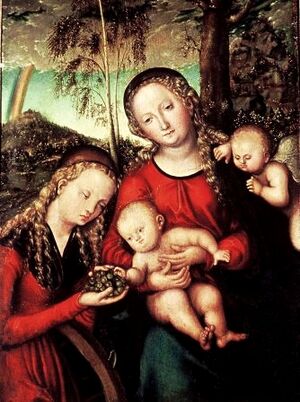
Sandomierz has many interesting places to visit, showing its rich history:
- Churches:
- Church of the Holy Spirit
- Church of St. Jacob, where the Lesser Polish Way walking trail begins.
- Church of St. Joseph
- Church of St. Michael
- Church of St. Paul
- Sandomierz Cathedral, built in 1360 and later updated in the Baroque style.
- Historic Buildings:
- Collegium Gostomianum, one of Poland's oldest schools, started in 1602.
- Jan Długosz House, named after a famous Polish historian.
- Kamienica Oleśnickich (Oleśnicki Manor).
- Opatowska Gate (Brama Opatowska), a Gothic entrance to the city built by King Casimir.
- Sandomierz Castle, a medieval building on a hill near the Vistula River.
- Sandomierz Palace, also known as the Bishop's Palace.
- Sandomierz Synagogue, a brick building from 1768 in the Polish Baroque style.
- Sandomierz Town Hall, a beautiful building in the main square.
- Other Attractions:
- Pepper Mountains nature reserve, a unique natural area.
- Diocesan Museum in Sandomierz, which holds many historical and religious items.
- Sandomierz Main Market Square, the heart of the Old Town.
Learning in Sandomierz
Sandomierz has several schools and colleges:
- Wyższa Szkoła Humanistyczno-Przyrodnicza Studium Generale Sandomiriense
- Wyższe Seminarium Duchowne w Sandomierzu
- 1 Liceum Ogolnoksztalcace Collegium Gostomianum
- 2 Liceum Ogólnokształcące im. Tadeusza Kościuszki
- Zespół Szkół Gastronomicznych i Hotelarskich
- Zespół Szkół Technicznych i Ogólnokształcących
Sports in Sandomierz
The local football team is Wisła Sandomierz. They play in the lower football leagues.
Sandomierz and Other Cities
Sandomierz is twinned with these cities, meaning they have a special friendship:
 Ostroh, Ukraine
Ostroh, Ukraine Volterra, Italy
Volterra, Italy Newark-on-Trent, United Kingdom
Newark-on-Trent, United Kingdom Emmendingen, Germany
Emmendingen, Germany
Images for kids
-
Church of the Conversion of Saint Paul
-
St. Jacob's Church, built in the 13th–14th century.
Famous People from Sandomierz
Many notable people have come from Sandomierz, including:
- Karol Bielecki (born 1982), a handball player.
- Wiktor Chabel (born 1985), a rower.
- Mikołaj Gomółka (1591–1609), a Polish Renaissance composer.
- Wincenty Kadłubek (1150–1223), a medieval historian.
- Karolina Kołeczek (born 1993), an athlete specializing in 100 meter hurdles.
- Stanisław Krawczyński (1884–1940), a medical doctor and member of the Polish Parliament.
- Wacław Król (1915–1991), a Polish military pilot.
- Wiesław Myśliwski (born 1932), a writer and winner of the Nike Award.
- Piotr Nurowski (1945–2010), a tennis player and former President of the Polish Olympic Committee.
- Sebastian Petrycy (1554–1626), a philosopher and physician.
- Gracjan Piotrkowski (1734–1785), a Catholic writer who debated religious topics.
- Andrzej Sarwa (born 1953), a Polish writer, poet, and journalist.
- Joseph Schleifstein (born 1941), a Holocaust survivor whose life inspired the movie Life Is Beautiful.
- Mikołaj Trąba (1358–1422), a Polish Roman Catholic priest and the first Primate of Poland.
- Stanisław Warszycki (c. 1600 – 1680/1681), a nobleman and powerful figure in the Polish–Lithuanian Commonwealth.
Online Views of Sandomierz
You can see Sandomierz online through webcams and virtual tours:
- City hall & façades of houses on the lower market square
- Panning: Gomulka's House, Kordegarda, Oleśnicki Family's House, rear façade of city hall, water well, Ciżemka
- Panorama
- Panning: City Hall, Main square and Opatowska Tower
- Google Street View
See Also
- Lesser Poland





